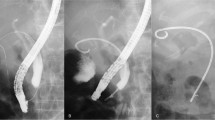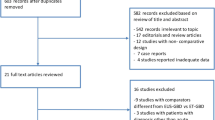Abstract
Background
Endoscopic gallbladder drainage (GBD) is an alternative to percutaneous GBD (PGBD) to treat acute cholecystitis, yielding similar success rates and fewer adverse events. To our knowledge, no cost-effectiveness analysis has compared these procedures. We performed an economic analysis to identify clinical and cost determinants of three treatment options for acute cholecystitis in poor surgical candidates.
Methods
We compared three treatment strategies: PGBD, endoscopic retrograde cholangiographic transpapillary drainage (ERC-GBD), and endosonographic GBD (EUS-GBD). A decision tree was created over a 3-month period. Effectiveness was measured using hospital length of stay, including adverse events and readmissions. Costs of care were calculated from the National Inpatient Sample. Technical and clinical success estimates were obtained from the published literature. Cost effectiveness was measured as incremental cost effectiveness and compared to the national average cost of one hospital bed per diem.
Results
Analysis of a hypothetical cohort of poor candidates for cholecystectomy showed that, compared to PGBD, ERC-GBD was a cost-saving strategy and EUS-GBD was cost effective, requiring $1312 per hospitalization day averted. Additional costs of endoscopic interventions were less than the average cost of one hospital bed per diem. Compared to ERC-GBD, EUS-GBD required expending an additional $8950 to prevent one additional day of hospitalization. Our model was considerably affected by lumen-apposing metal stent cost and hospital length of stay for patients managed conservatively and those requiring delayed surgery.
Conclusions
Endoscopic GBD is cost effective compared to PGBD, favoring ERC-GBD over EUS-GBD. Further efforts are needed to make endoscopic GBD available in more medical centers, reduce equipment costs, and shorten inpatient stay.




Similar content being viewed by others
References
Das S, Mahakkanukrauh P, Ho CC (2016) The burden of gastrointestinal, liver, and pancreatic diseases: the global scenario. Gastroenterology 150(4):1045–1046
Peery AF et al (2015) Burden of gastrointestinal, liver, and pancreatic diseases in the United States. Gastroenterology 149(7):1731–1741
Margiotta SJ Jr, Willis IH, Wallack MK (1988) Cholecystectomy in the elderly. Am Surg 54(1):34–39
Werbel GB et al (1989) Percutaneous cholecystostomy in the diagnosis and treatment of acute cholecystitis in the high-risk patient. Arch Surg 124(7):782–785; discussion 785-786
Khan MA et al (2017) Efficacy and safety of endoscopic gallbladder drainage in acute cholecystitis: is it better than percutaneous gallbladder drainage? Gastrointest Endosc 85(1):76–87
Siddiqui A et al (2018) Three-way comparative study of endoscopic ultrasound-guided transmural gallbladder drainage using lumen-apposing metal stents versus endoscopic transpapillary drainage versus percutaneous cholecystostomy for gallbladder drainage in high-risk surgical patients with acute cholecystitis: clinical outcomes and success in an International. Multicenter Study. Surg Endosc 33(4):1260–1270
Smith TJ et al (2013) Changing trends and outcomes in the use of percutaneous cholecystostomy tubes for acute cholecystitis. Ann Surg 257(6):1112–1115
Teoh AYB et al (2017) Endoscopic ultrasound-guided gallbladder drainage reduces adverse events compared with percutaneous cholecystostomy in patients who are unfit for cholecystectomy. Endoscopy 49(2):130–138
Anderloni A et al (2016) Endoscopic ultrasound-guided transmural stenting for gallbladder drainage in high-risk patients with acute cholecystitis: a systematic review and pooled analysis. Surg Endosc 30(12):5200–5208
Han D et al (2018) Lumen apposing metal stents (LAMSs) for drainage of pancreatic and gallbladder collections: a Meta-analysis. J Clin Gastroenterol 52(9):835–844
Khan MA et al (2016) Endoscopic Ultrasound-guided biliary drainage: a systematic review and meta-analysis. Dig Dis Sci 61(3):684–703
Sharaiha RZ et al (2017) Efficacy and safety of EUS-guided biliary drainage in comparison with percutaneous biliary drainage when ERCP fails: a systematic review and meta-analysis. Gastrointest Endosc 85(5):904–914
Miura F et al (2018) Tokyo Guidelines 2018: initial management of acute biliary infection and flowchart for acute cholangitis. J Hepatobiliary Pancreat Sci 25(1):31–40
Sanders GD et al (2016) Recommendations for conduct, methodological practices, and reporting of cost-effectiveness analyses: second panel on cost-effectiveness in health and medicine. JAMA 316(10):1093–1103
HCUP net:. Health care cost and utilization project. Accessed 22 Sept 2017
Healthcare Cost and Utilization Project, A.f.H.R.a.Q. Overview of the National (nationwide) Inpatient Sample (NIS). 2016. www.hcup-us.ahrq.gov/nisoverview.jsp. Accessed 2 Apr 2019
Chen YI et al (2018) Cost-effectiveness analysis comparing lumen-apposing metal stents with plastic stents in the management of pancreatic walled-off necrosis. Gastrointest Endosc 88(2):267–276
Fleming MM et al (2019) A propensity score matched comparison of readmissions and cost of laparoscopic cholecystectomy vs percutaneous cholecystostomy for acute cholecystitis. Am J Surg 217(1):83–89
Doubilet P et al (1985) Probabilistic sensitivity analysis using Monte Carlo simulation. A practical approach. Med Decis Making 5(2):157–177
American Hospital Association. 1999–2016 AHA Annual Survey. 2018. http://www.ahaonlinestore.com. Accessed 11 Nov 2018
Russell LB, Fryback DG, Sonnenberg FA (1999) Is the societal perspective in cost-effectiveness analysis useful for decision makers? Jt Comm J Qual Improv 25(9):447–454
Kedia P et al (2015) Endoscopic gallbladder drainage compared with percutaneous drainage. Gastrointest Endosc 82(6):1031–1036
Keswani RN et al (2017) Association between endoscopist and center endoscopic retrograde cholangiopancreatography volume with procedure success and adverse outcomes: a systematic review and meta-analysis. Clin Gastroenterol Hepatol 15(12):1866–1875
Mayumi T et al (2018) Tokyo Guidelines 2018: management bundles for acute cholangitis and cholecystitis. J Hepatobiliary Pancreat Sci 25(1):96–100
Saumoy M et al (2018) Successful cholecystectomy after endoscopic ultrasound gallbladder drainage compared with percutaneous cholecystostomy, can it be done? J Clin Gastroenterol 53:231–235
Zhang K et al (2018) Retrievable puncture anchor traction method for EUS-guided gallbladder drainage: a porcine study. Gastrointest Endosc 88(6):957–963
Perez-Miranda M (2018) Technical considerations in EUS-guided gallbladder drainage. Endosc Ultrasound 7(2):79–82
Siddiqui A et al (2018) Three-way comparative study of endoscopic ultrasound-guided transmural gallbladder drainage using lumen-apposing metal stents versus endoscopic transpapillary drainage versus percutaneous cholecystostomy for gallbladder drainage in high-risk surgical patients with acute cholecystitis: clinical outcomes and success in an International, Multicenter Study. Surg Endosc 33:1260–1270
Marseille E et al (2015) Thresholds for the cost-effectiveness of interventions: alternative approaches. Bull World Health Organ 93(2):118–124
Papanicolas I, Woskie LR, Jha AK (2018) Health care spending in the united states and other high-income countries. JAMA 319(10):1024–1039
Author information
Authors and Affiliations
Corresponding author
Ethics declarations
Disclosures
Drs Corral, Das, Krӧner, Gomez, and Wallace have no conflicts of interest or financial ties to disclose.
Additional information
Publisher's Note
Springer Nature remains neutral with regard to jurisdictional claims in published maps and institutional affiliations.
Electronic supplementary material
Below is the link to the electronic supplementary material.
Rights and permissions
About this article
Cite this article
Corral, J.E., Das, A., Krӧner, P.T. et al. Cost effectiveness of endoscopic gallbladder drainage to treat acute cholecystitis in poor surgical candidates. Surg Endosc 33, 3567–3577 (2019). https://doi.org/10.1007/s00464-019-07026-z
Received:
Accepted:
Published:
Issue Date:
DOI: https://doi.org/10.1007/s00464-019-07026-z




